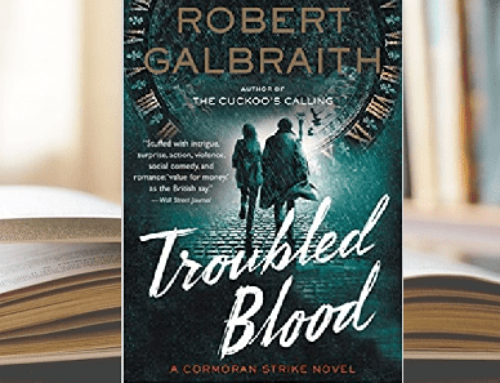[by Ross Browne]
Dean Koontz is a very funny guy who while contemplating his future as a geriatric (bunny slippers are involved) says he expects to feel then as he does now: that Watchers is the most satisfying book he’s ever written. He also believes many readers will think it to be his best, no matter how good any other books he has written—or will write in the future—may be.
The editor in me can’t help wondering what’s so special about this story to an author who has written so many really good novels—really good best-selling novels. I’m also interested in what novelists (and editors) can learn from what Koontz does so well here.
The Story
Let’s start with the plot premise, which his publisher presents in this way:
On his thirty-sixth birthday, Travis Cornell hikes into the foothills of the Santa Ana Mountains. But his path is soon blocked by a bedraggled golden retriever who will let him go no further into the dark woods.
That morning, Travis had been desperate to find some happiness in his lonely, seemingly cursed life. What he finds is a dog of alarming intelligence that soon leads him into a relentless storm of mankind’s darkest creation.
Sounds pretty good, right? Lonely guy has a chance encounter with a very smart dog who draws him into conflict with something sinister. Koontz being Koontz, we know this is going to go someplace interesting, and probably pretty terrifying.
Add in what the summary doesn’t mention—a cunning serial killer who manages to monetize his psychotic instincts, a suspenseful manhunt entwined with a wildly original stalking subplot, law enforcement turf wars, and a good old-fashioned story of the redemptive power of love—and you’ve got the makings for a terrific thriller. One with some real heart, which I suspect is an important part of Watcher’s popularity.
The Challenges
What interests me most about this novel from a craft standpoint is how its author navigates two challenges unique to this particular kind of story. First, Koontz compresses a dramatic and rather extreme transformation of a lead character into a short span of pages while making it convincing and wildly entertaining. Second, he renders a dog’s profound intelligence so intelligently that this golden retriever’s ability to communicate with humans is actually believable.
Character arc is generally thought of as the way in which a character changes over the course of a story, usually in response to plot events. The bigger or more extreme the character arc, the greater the degree of transformation.
Many thrillers and suspense novels are more plot-driven than character-driven and thus don’t serve up much in the way of notable character arcs. This approach may serve pacing well by allowing the author to stay focused on plot and action, but the end result is rarely all that satisfying. If there’s one thing nearly three decades of editing fiction has taught me, it’s that the best stories, no matter what their genre, tend to be those where the events of the plot have some kind of significant impact on the characters.
In most novels that do have real character arcs, the transformation is usually quite gradual, taking place over the course of the entire novel and easing readers into the evolving status quo of the character in question. Not so in Watchers.
Consider Nora Devon, who at the start of the book has spent her entire life as a shut-in, thanks to an aunt I suspect was mentally ill. Nora has never been to a restaurant or had meaningful interaction with anyone other than her aunt, so it’s no surprise that when the aunt dies she has zero self-esteem, zero real-life experience, and very limited understanding of how the world works. For Nora, there are only two kinds of people in the world: cats and mice. Nora learned from her aunt that she will always be a mouse. A victim. One to whom things happen rather than one who makes things happen. The only way to protect herself is to isolate and remain a recluse.
The main plot of the book demands that Nora shake off these emotional shackles quickly and be in a far more functional state by the time the screws of the story start to tighten in earnest.
Artful Handling of Characterization
Koontz’s rendering of the journey from vulnerable social recluse to a confident well-adjusted co-protagonist is as skillful as it is surprising. It starts with Nora being harassed, threatened, and then stalked in chilling fashion by a sexual and psychological predator who believes he can get away with anything with this strange, broken woman. But rather than withering in the face of his aggression, Nora finds unsuspected courage within herself. Soon she starts taking small, deliberate steps to a healthier, more balanced existence, even as the harassment continues. One of these steps puts her in contact with former Special Forces operative Travis Cornell and his newfound preternaturally brilliant dog Einstein—who together only a few pages later save Nora from being raped and perhaps worse.
Though she can’t believe anyone would take interest in her out of anything but pity, she begins seeing Travis socially and soon starts to see herself in a refreshing new light. Together, Travis and Einstein help coax Nora from her damaged, isolated state into a happier and more normal existence. She delights in their affection and companionship and is actually married, pregnant, considerably more life-savvy by the time the story demands she have her act together, less than halfway through the book. It’s a striking and dramatic transformation, quite unlike what readers usually find in thrillers.
Koontz artfully weaves all this transformation into the span of no more than a hundred pages, many of which are focused on other viewpoints, plot events, and subplots. And by the time the two main threats that drive the plot reach our protagonists’ doorstep, Nora is ready for all this crazy story can dish out. She’s strong, capable, even formidable in her own way. And there’s much to admire in how Koontz makes this work.
First, he makes both extremes of Nora’s character arc, the starting point and ending point, quite interesting. Shut-in Nora is both sympathetic and believable as an emotionally handicapped, somewhat dysfunctional person, and there are memorable scenes that enable us to see for ourselves her state of mind during this period, particularly as the twisted Arthur Streck recognizes how sheltered she’s been and how easy it will be to take advantage of her. It’s creepy, exciting, and suspenseful. There’s a good deal of menace and danger involved, which helps dramatize her state of mind early in the novel in deliciously thrillerish fashion.
Healthy, well-adjusted Nora is interesting, too, and not just because she’s experiencing life with almost childish glee. It turns out she’s quite beautiful for one thing—something others have noticed but she was unable to see in herself. She’s also a talented painter, a quick thinker, an enthusiastic lover, and as smart and kind and pleasurable in company as anyone Travis has ever met. And then she has wonderful patience (which Travis lacks) in teaching this already brilliant dog how to communicate with humans with heightened precision. Travis may be the ex-Delta Force action hero who can handle a gun and find fake drivers’ licenses on a moment’s notice in the middle of San Francisco. But it’s Nora who drives an important part of the plot forward and helps make the character of Einstein such a compelling asset to the story.
In crankier moments, I’ve been known to rant about how grating I find it when authors with male protagonists (published best-sellers among them) treat female love interests as bystanders and don’t fully integrate them into the fabric of the plot. Time and again I’ve found that characterization deepens and improves commensurately with a character’s influence on plot. I’ve come to the belief that fully realized characters almost always need to affect change and impact story with their behavior, not just react to what’s happening.
Characterization Via Plot Influence
I’ve seen firsthand how giving a flat or uninteresting character more of an active role in the plot—making them responsible for even just one key point of change or story development—can help that character become whole. Characters who assert themselves—whose wants, opinions, and suggestions are taken seriously by others in the book—are always going to be more interesting than ones who simply go along with the main protagonists’ decisions or just tag along with the events.
I think a good deal of Nora’s strength as a character stems from her active role in both plot and subplot. She’s the one who decides it’s time to leave her old self behind. She’s the one who drills down into the effort to help Einstein communicate with her owners. And she does both in ways that give her own personality, temperament, and intelligence the opportunity to shine—in scenes that play out before readers’ eyes.
There are all sorts of things some authors might tell readers about Nora that Koontz shows us in what she says and does. He uses some narrative exposition to help us understand what she’s been through and why she is the way she is at the beginning of the book, but this comes to the page very organically. Most of our sense of her character comes from seeing her in action.
Finally, Koontz invents three effective triggers to convincingly set the transformation in motion.
Character Development in Reaction to Plot Events
First Nora’s aunt dies, leaving her with money, a house, and freedom from the paranoid, controlling, oppressive mindset that messed Nora up so badly in the first place. This in itself is a credible catalyst for change.
Second, Koontz steers Nora into this weird series of encounters with a deranged man who pops the bubble of isolation and naïveté and introduces a much more real, dangerous world—and thus compels her to face some hard realities and deal with them.
Third, she gets friendly with Travis and, through him, Einstein, both of whom give her the opportunity to experience life in a new way. It all fits together so comfortably, even artfully in my view. There’s nothing forced about it, nothing that feels author-manipulated. And none of the focus on what happened bogs down the pace or makes the book any less suspenseful. There are many other balls in the air and plenty of interesting, more traditional thriller fare going down while Nora gets her act together.
It’s not long before Nora settles comfortably into a leadership role in teaching Einstein to communicate via a process that’s interesting in its own right and fun to read about. Before long the dog is reading books, staying on alert for his enemy, and chatting with his new owners using Scrabble tiles.
It all plays more believably than you might think. This thread of the story brought me back to a fantasy I know I’m not alone in having had when I was a kid: I wished my dog could talk. Dean Koontz grants that wish, if only fleetingly, and in a way I think most readers find satisfying. That’s a small but important part of what makes Watchers so special.
It all comes together so well, Nora’s fast-track character arc and the story elements that make Einstein such a unique and memorable character. He’s a dog that can talk. (Well, sort of.) Who knows things. Who facilitates survival and helps fight the good fight. Who even makes jokes.
And Koontz makes readers believe this. Or at least forget about our natural impulse to not believe it.
Believability and Suspension of Disbelief
First, Koontz makes it so there’s almost nothing supernatural, magical, or mythical about the dog’s abilities. Without getting too deep into the science of how this might actually happen, Koontz makes Einstein’s extraordinary abilities the result of top-secret genetic engineering. This makes the dog’s intelligence much easier to accept and keeps readers grounded in a world where the rules of reality appear to still apply. The story is better as a result of how convincing the notion is that science could really deliver such a creature and that our own government might have keen interest in the research. (And the same holds true for Einstein’s nemesis, another genetically engineered animal bred for aggression and proficiency as a perfect killing machine.)
Second, Koontz anchors the thing that made the dog the way he is—originally, I mean, before Nora and Travis get hold of him—firmly to the plot. Einstein became who he is for a reason, not out of serendipity or because the author needed him to be this way. There are good reasons his intelligence has been engineered. Good reasons—or at least believable reasons—the entities responsible for his existence can’t have their work discovered. Good reasons that good guys and bad guys alike must find Einstein and for Einstein, Nora, and Travis to go underground and stay on the lam.
There’s more good that can be said about Koontz’s handling of Nora’s and Einstein’s characters, character arc in general, and integration of quality characterization with a page-turning, fast-paced thriller. But it’s best experienced firsthand. If you haven’t read Watchers, do yourself a favor and get a copy. And be sure to read Koontz’s comments about the book, which I think any writer would find entertaining and informative.
If you’ve had the pleasure of reading Watchers, I hope you share my appreciation for this fine example of how smart and artful characterization can be in a crime thriller while staying firmly in the lane of commercial fiction.
Parting Thoughts on Characterization and Character Arc for Novelists and Short Story Writers
1. The first question to ask about character arc is whether you have one in the first place. Take a close look at your main character(s) and ask yourself how different they are when the novel starts and when it ends. You might consider a simple scale of 1-5, with 1 being zero transformation and 5 being rather intense. (I’d give Nora a 4 or a 5 in Watchers.) If an important character who’s central to the story rates low on the scale, that may signal an opportunity to make the book more interesting and complex by inventing a more dramatic character arc—or better yet, finding it within the natural trajectory of the plot.
If your key characters already rate mid or better on that scale, good for you! In this case, it may be time to make sure that the start point and end points of the transformation are sufficiently interesting and effectively rendered. (See points 2 and 3.)
2. Consider those two endpoints on the spectrum, what the character is like at the beginning of the novel and then at the end. Ask yourself how inherently interesting each condition is. Take a step back and try to be as objective as you can about how much interest you can expect readers to take in the character at both the start and the finish whatever transformation takes place.
Many characters in fiction will be living a humdrum life before the events of the story throw that life into turmoil. It’s fine, of course, if their life is boring, but avoid the mistake of letting the character come across as boring. Good characters can still engage readers even if they’re bored, dissatisfied, or living a life in which nothing unexpected happens.
3. Remember that it’s usually best to convey the starting point of your character’s arc in scenes rather than with too much narrative exposition. Resist the urge to explain your character’s initial status quo to us. Show them at the beginning of their character journeys. Find ways to showcase personality, temperament, worldview, and maybe even sense of humor—even if they’re just grinding through a humdrum life at the start of the novel. If you’re having a hard time with this, consider a new plot event and resulting opportunity to show your character doing something interesting, asserting themselves, or making an influential decision.
Nora’s conflict with Arthur Streck isn’t vital to the main plot of Watchers. Yet it’s exciting and suspenseful in its own right, serves as an effective trigger, and is a brilliant way of showing us what Nora is like then. (And Arthur Streck is quite a well-drawn character, especially for a bit player. I won’t be forgetting him anytime soon.)
4. Remember that character arcs do not need to be extreme to be effective. In Watchers, Nora’s transformation is quite dramatic, but Travis’s really isn’t. His journey is more about learning to love again after brutal losses in his personal life and shedding the notion that he is somehow cursed. Ditto for Einstein, who isn’t all that different at the end of the book from he how he is at the beginning yet still seems to have evolved a bit in a satisfying way, human in some respects.
5. If you feel that a character is bland, uninteresting, or simply forgettable, look for unmined potential in how they can affect plot at whatever stage seems problematic. (You might give them something significant and interesting to do, perhaps a result to bring about a deeper effect on the story.) Characters who are reactive bystanders rather than active participants in shaping the outcome of the plot are unlikely to hold our interest.
6. Finally, remember that character arcs aren’t only for your good guys. Your antagonists will usually be more effective as characters if they change over the course of the story.







